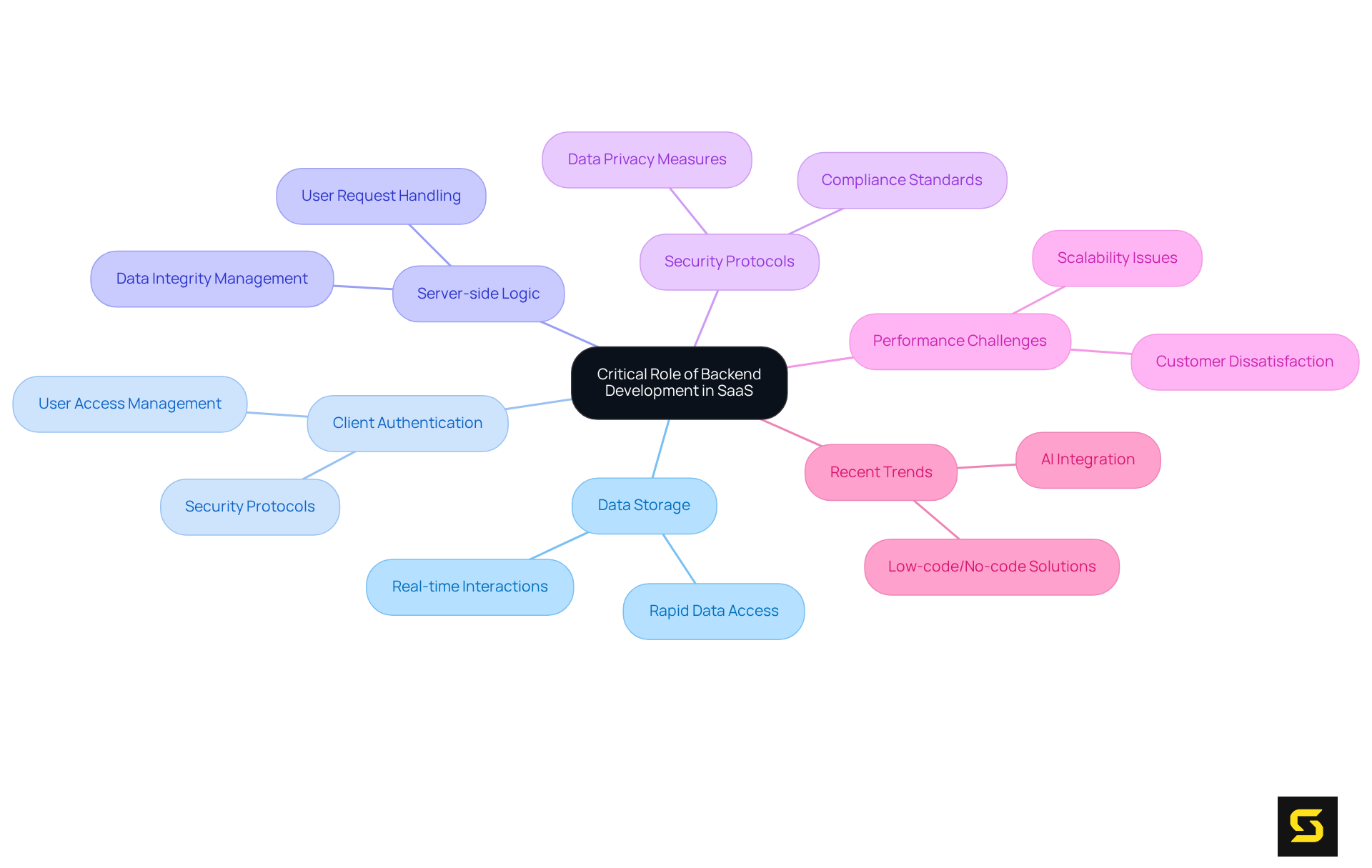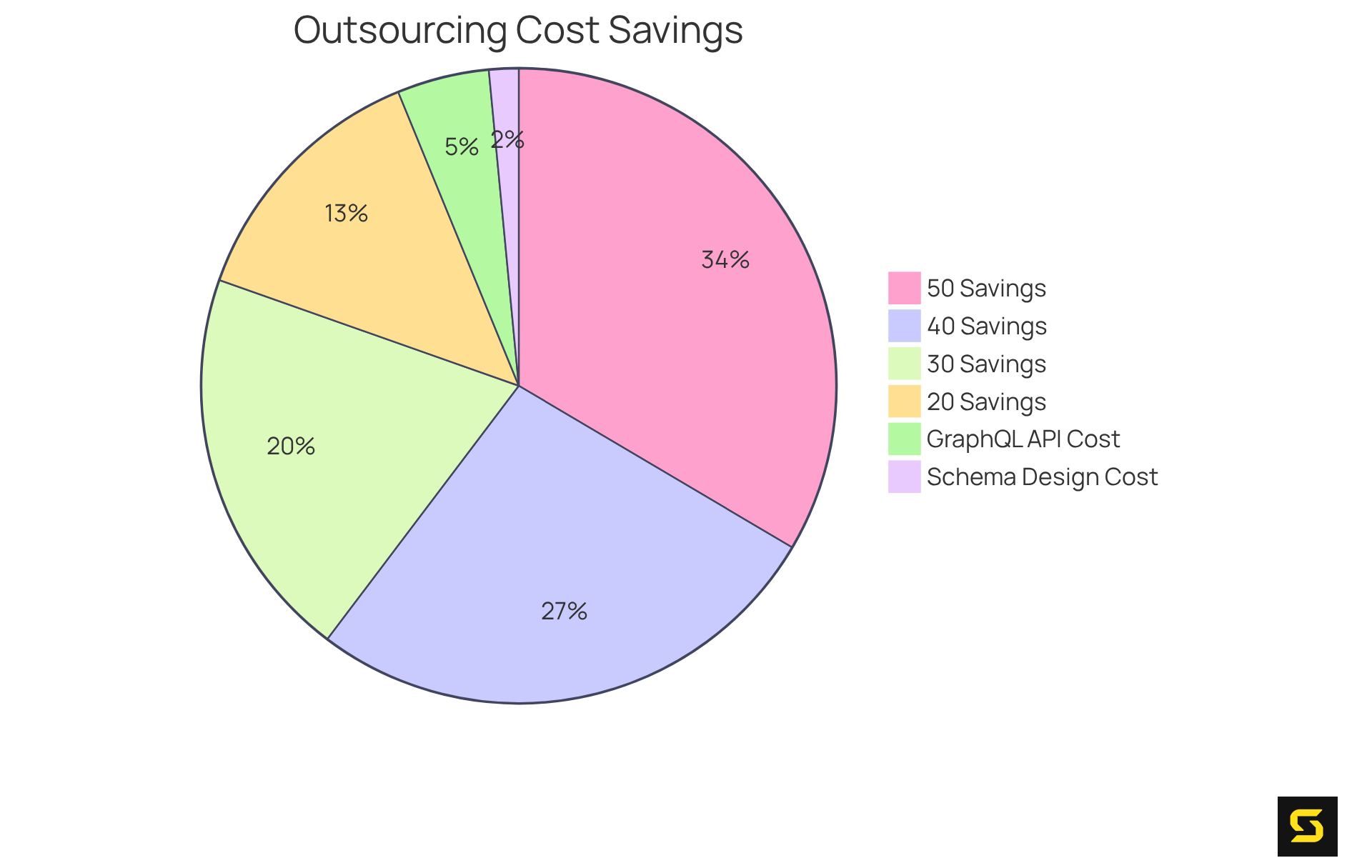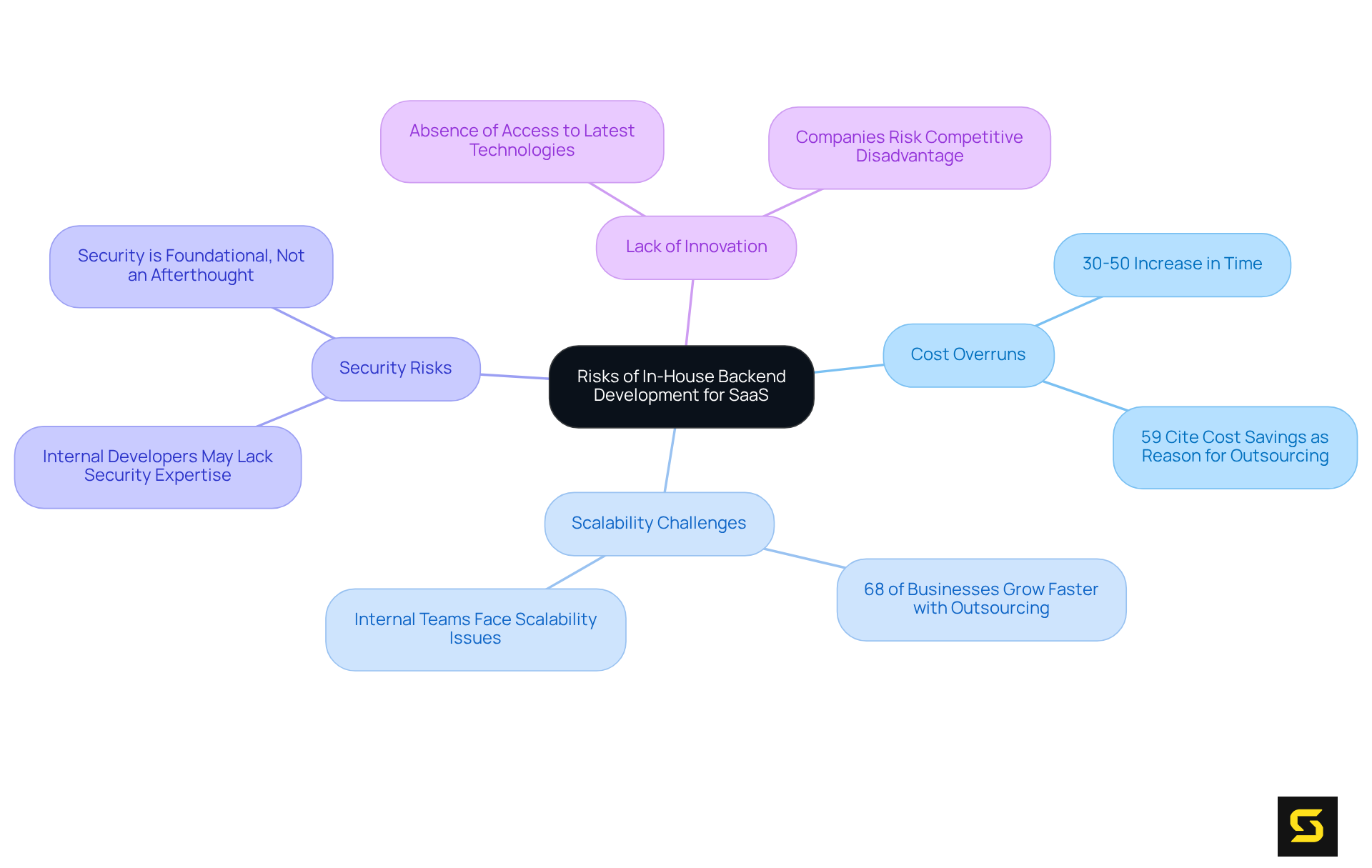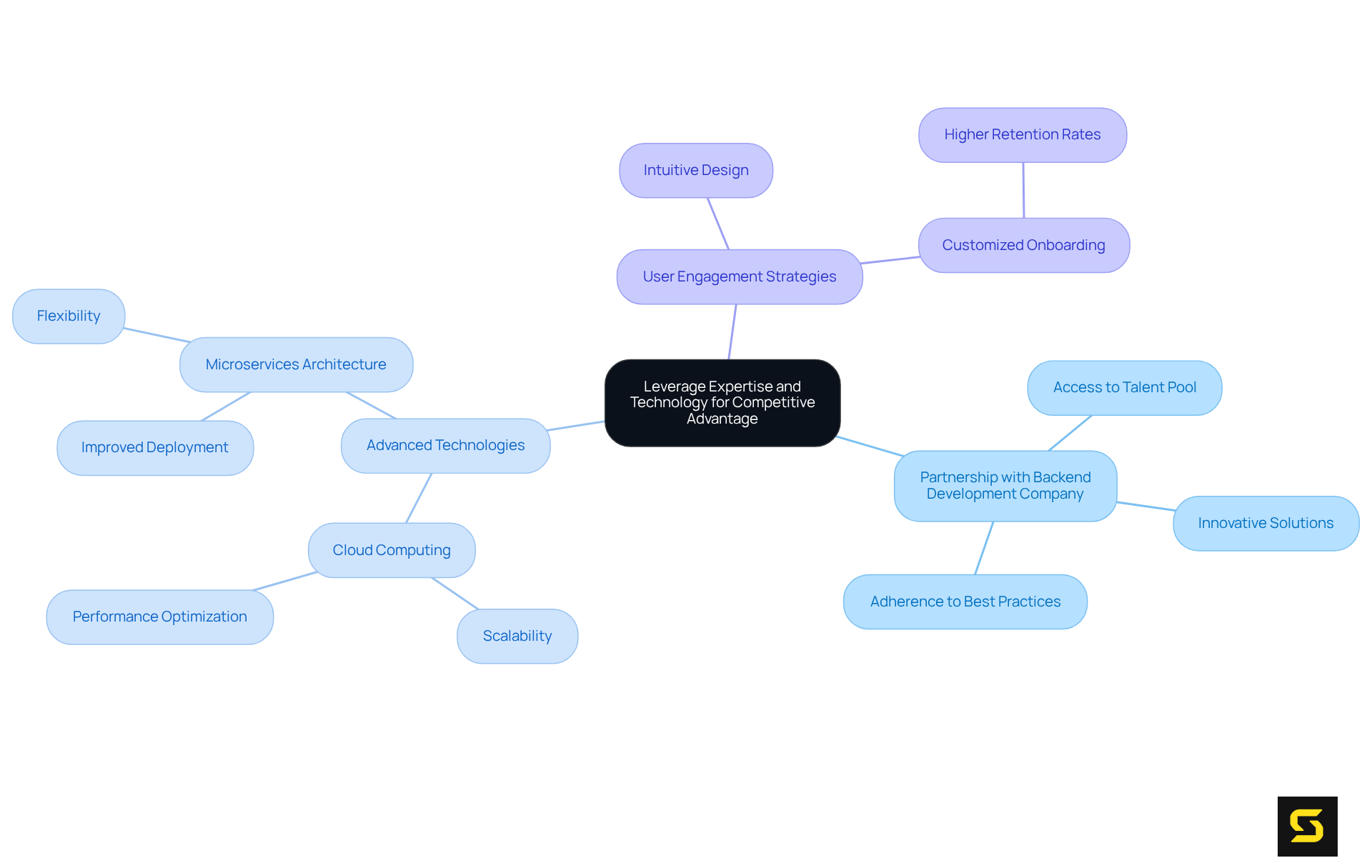Overview
Partnering with a backend development company is a game-changer for SaaS success. This collaboration brings essential expertise in server-side technology, which is crucial for optimizing performance, scalability, and security. Such partnerships not only lead to reduced costs and shorter project timelines but also significantly enhance product quality and innovation. By positioning SaaS companies to thrive in a competitive market, these alliances are indispensable. Embrace the opportunity to elevate your SaaS offerings—collaborate with a backend development expert today.
Introduction
The backbone of any successful Software as a Service (SaaS) application is its backend development—a critical component that guarantees seamless user experiences and robust data management. By collaborating with a specialized backend development company, SaaS providers can tap into a wealth of expertise, enhancing performance, scalability, and security while significantly reducing operational costs.
However, the allure of in-house development often obscures the substantial risks and challenges that can emerge, including cost overruns and security vulnerabilities. How can organizations navigate these complexities to ensure their SaaS offerings not only survive but thrive in a competitive landscape?
Understand the Critical Role of Backend Development in SaaS
A backend development company provides the bedrock for any Software as a Service application, playing a pivotal role in data storage, client authentication, and server-side logic. A meticulously structured server architecture, provided by a backend development company, guarantees that applications adeptly manage user requests, uphold data integrity, and deliver a seamless user experience.
For instance, in healthcare software platforms, a robust infrastructure facilitates rapid data access and processing, which is crucial for real-time interactions, such as managing patient records or tracking fitness progress in health applications. Moreover, the backend development company is responsible for enforcing stringent security protocols to safeguard sensitive information, making it indispensable in sectors where data privacy is paramount.
Without a resilient infrastructure, software as a service applications face performance challenges, security vulnerabilities, and ultimately, customer dissatisfaction. Recent trends indicate a growing emphasis on integrating AI and low-code/no-code solutions into server-side programming, further enhancing the efficiency and adaptability of software-as-a-service offerings.
As organizations increasingly rely on data-driven insights, the system's role in overseeing authentication and data storage becomes even more significant, ensuring that individuals have secure and reliable access to their information anytime, anywhere.

Explore the Benefits of Collaborating with Backend Development Experts
Collaborating with a backend development company that specializes in server-side technology presents significant advantages for SaaS companies. These experts bring a wealth of experience and knowledge, facilitating the adoption of best practices and advanced technologies that significantly boost application performance and scalability.
For instance, a dedicated server-side team can optimize database administration and server configurations, ensuring applications effectively handle high user traffic without sacrificing speed or reliability. Specific tasks, such as relational schema design, can cost between $1,500 and $3,000, while GraphQL API development may range from $5,000 to $9,000, underscoring the financial implications of outsourcing these complex server-side functions.
This specialized expertise allows a backend development company to concentrate on its core competencies while delegating support tasks, resulting in improved operational efficiency. Furthermore, such partnerships often lead to substantial cost savings; businesses can avoid the overhead associated with hiring and training in-house developers.
Statistics indicate that outsourcing server-side programming can significantly reduce project costs, with typical savings ranging from 20% to 50% compared to maintaining an internal team. Ultimately, leveraging external expertise not only accelerates project timelines but also contributes to a more robust final product, positioning software companies for greater success in a competitive landscape.

Assess the Risks of In-House Backend Development for SaaS Products
While the allure of internal server-side creation may be strong, it carries significant risks that can jeopardize the success of SaaS products. A primary concern is the potential for cost overruns; internal teams often lack the specialized skills necessary to efficiently manage complex tasks, making it essential to collaborate with a backend development company. This skill gap can lead to delays and increased expenses, ultimately affecting both the project’s timeline and budget. For instance, businesses relying solely on internal teams may experience time increases of 30-50%, particularly when scaling to meet unexpected surges in user demand. Conversely, outsourcing can yield a 30-50% reduction in product creation time, underscoring the effectiveness of external collaborations.
Furthermore, in-house teams frequently face scalability challenges, hindering their ability to adapt to fluctuating workloads. In fact, 68% of businesses grow more rapidly with outsourced programming teams, highlighting the advantages of external collaboration. Security vulnerabilities also pose a significant risk; internal developers may lack the expertise to implement robust security measures effectively, leaving organizations vulnerable to potential breaches. As Vainu states, "Security isn’t an afterthought — it’s foundational," which underscores the critical nature of security in software development.
Moreover, the absence of access to the latest technologies and best practices can stifle innovation, placing companies at a competitive disadvantage in a rapidly evolving market. Financially, 59% of companies cite cost savings as the primary reason for outsourcing software creation, making it imperative for organizations to consider the ramifications of cost overruns associated with in-house efforts.
Given these factors, organizations must meticulously evaluate the risks tied to developing internal capabilities. The potential for cost overruns, combined with scalability and security challenges, underscores the importance of working with a backend development company for infrastructure development to ensure the success and sustainability of software-as-a-service offerings.

Leverage Expertise and Technology for Competitive Advantage
In the fiercely competitive software-as-a-service landscape, leveraging knowledge and cutting-edge technology is essential for securing a competitive edge. Partnering with a seasoned backend development company grants access to a rich talent pool that delivers innovative solutions and adheres to industry best practices. This strategic collaboration enables the deployment of advanced technologies, such as cloud computing and microservices architecture, which markedly improve scalability and flexibility.
For example, cloud-based solutions empower software applications to scale seamlessly in response to fluctuating demand, ensuring optimal performance consistently. Research indicates that organizations managing an average of 275 software applications encounter challenges like license waste and integration complexity, underscoring the necessity for a backend development company to provide robust support.
Moreover, expert developers provide invaluable insights into user engagement strategies, allowing businesses to design more intuitive and user-friendly applications. By harnessing these resources, SaaS companies not only enhance their product offerings but also drive significant business growth and customer satisfaction, positioning themselves for enduring success.

Conclusion
Partnering with a backend development company is essential for the success of Software as a Service (SaaS) applications, as it provides the necessary infrastructure and expertise to ensure seamless performance, security, and scalability. This collaboration enables businesses to concentrate on their core competencies while leveraging specialized knowledge that enhances application reliability and user satisfaction.
The myriad benefits of such partnerships are significant, including access to advanced technologies, cost savings, and improved operational efficiency. By outsourcing backend functions, companies can sidestep the pitfalls associated with in-house development, such as skill gaps, security vulnerabilities, and scalability challenges. Additionally, insights from experienced backend developers can lead to more intuitive applications that drive customer engagement and satisfaction.
Ultimately, embracing the expertise of a backend development company not only mitigates risks but also positions SaaS businesses to thrive in a competitive landscape. As the industry evolves, leveraging cutting-edge technology and best practices will be crucial for sustained growth and innovation. Organizations are strongly encouraged to consider these strategic partnerships as a means to enhance their offerings and secure a competitive advantage in the ever-changing SaaS market.
Frequently Asked Questions
What is the role of backend development in SaaS applications?
Backend development is crucial for SaaS applications as it manages data storage, client authentication, and server-side logic, ensuring applications can handle user requests, maintain data integrity, and provide a seamless user experience.
Why is a robust backend infrastructure important in healthcare software platforms?
A robust backend infrastructure in healthcare software allows for rapid data access and processing, which is essential for real-time interactions like managing patient records or tracking fitness progress.
What security measures do backend development companies implement?
Backend development companies enforce stringent security protocols to protect sensitive information, making them vital in sectors where data privacy is critical.
What challenges do SaaS applications face without strong backend infrastructure?
Without a resilient backend infrastructure, SaaS applications can experience performance issues, security vulnerabilities, and customer dissatisfaction.
What recent trends are influencing backend development in SaaS?
Recent trends include a growing emphasis on integrating AI and low-code/no-code solutions into server-side programming, which enhances the efficiency and adaptability of SaaS offerings.
How does backend development support data-driven insights for organizations?
Backend development oversees authentication and data storage, ensuring secure and reliable access to information, which is increasingly important as organizations depend on data-driven insights.





